Личное впечатление от использования объектива 7Artisans 35/1.2
Пожалуй, начну с самого главного — мне очень зашел рисунок этого стекла. Он клевый, творческий и, если так можно выразиться, породистый. Такими словами я не хочу отнести 7Artisans 35/1.2 к разряду, действительно, топовых объективов или как-то возвысить его, но он и правда необычный. Работа с этим стеклом позволяет взглянуть на фотографию под другим углом. Это то, что мне было нужно. Причем эта его особенность проявляется в самых неожиданных сюжетах. Словами это трудно описать.
Про дизайн упомянул выше. Как по мне, он — «пушка». В совокупности с камерой фуджи получается по-настоящему олдскульная штука в руках, которая позволяет усилить ощущения от процесса фотографии.
В добавок ко всему, в реальной жизни 7Artisans 35/1.2 очень маленький. На фото в интернете он кажется больше. В плане мобильности, когда по этой причине камеру хочется взять с собой — это неоспоримый плюс. Но отсюда вытекает и один минус. О нем позже.
 Viltrox 56/1.4 рядом с 7Artisans 35/1.2
Viltrox 56/1.4 рядом с 7Artisans 35/1.2
У меня как-то был 7Artisans 25/1.8. Так вот по качеству и сборке 35/1.2 на него сильно похож. Хотя, возможно, на уровне тактильных ощущений немного приятнее. Коробочная комплектация у них аналогичная за исключением передней крышки. У 7Artisans 35/1.2 она металлическая и тоже под ретро. По отзывам в сети у многих она отваливается. Я же ее не использую, так как накрутил защитный фильтр. А на него крышка не садится. Да и нет необходимости.
И не могу не отметить среди плюсов стоимость, которая колеблется в районе $120. В день скидок мне удалось купить его значительно дешевле, что сопоставимо со стоимостью более дешевых линз с аналогичными характеристикам (например, Pergear 35/1.2 или Neewer 35/1.2).
Оптические характеристики — самая слабая сторона 7Artisans 35/1.2. Дисторсия, оптические искажения, виньетка и прочие «прелести» — все это про него. Стекло не пройдет тест на кирпичную стену Так что, если этот критерий важен, даже не смотрите в сторону этого объектива.
Работая на F1.2, трудно попасть в резкость. Поэтому в большинстве случаев на этом значении возможна съемка только статичных сюжетов. Хотя признаться, пару раз мне удавалось получать семейные портреты в динамичных сценах. Наверное, мне повезло
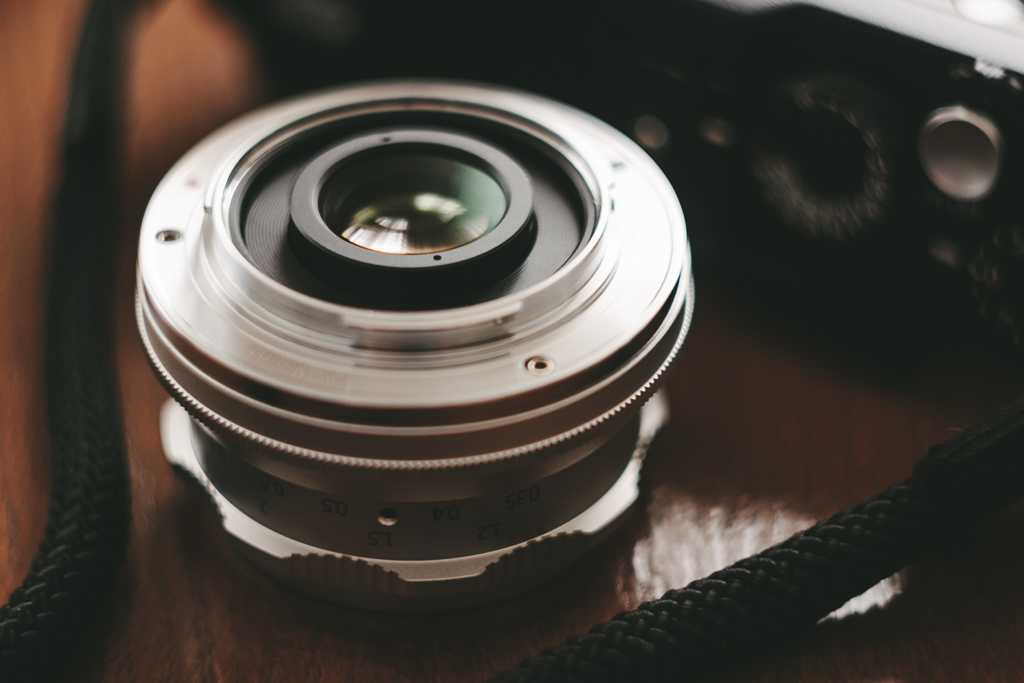 Байонет 7Artisans 35/1.2
Байонет 7Artisans 35/1.2
У объектива легко сбивается диафрагма. Я не раз возвращался к мысли, что по этой причине надо было брать вторую версию, у которой кольцо управления настройками с кликами. Сейчас прорабатываю решение — придумать какой-нибудь «костыль», позволяющий сделать фиксацию положения. Уж очень жутко бесит этот момент.
А еще 7Artisans 35/1.2 проблематично снять с камеры. Это отрицательный момент, вытекающий из компактности. Объектив сделан так, что, куда бы ты ни дотронулся, пальцами попадаешь или на кольцо фокусировки, или на управление диафрагмой. Приходится с усилием обхватывать его целиком, чтобы прокрутить и отсоединить от байонета.
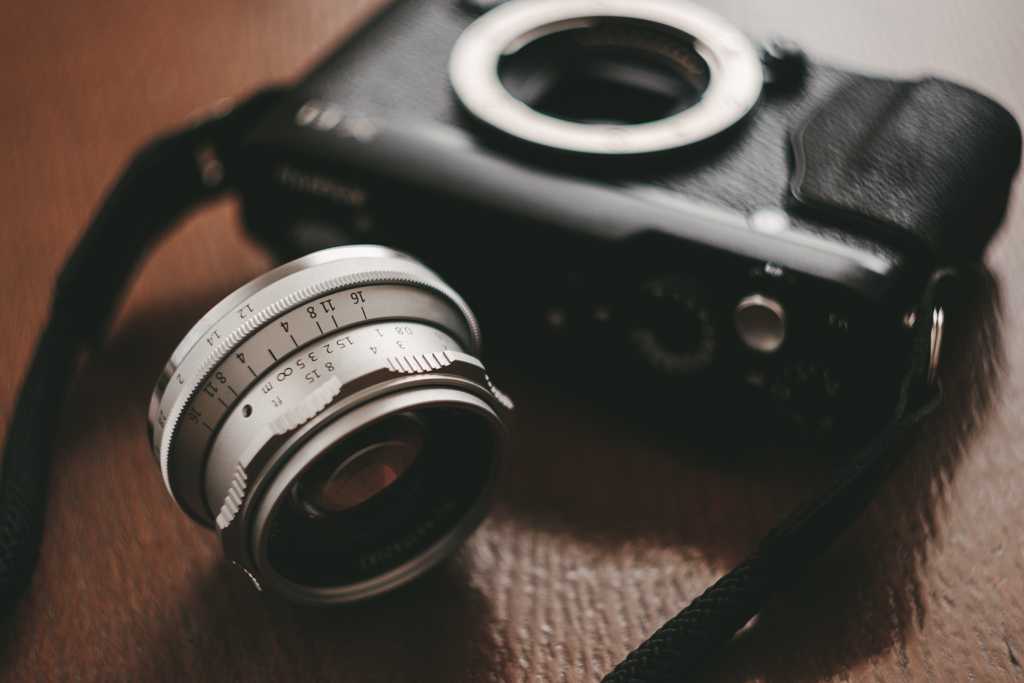 Объектив 7Artisans 35/1.2
Объектив 7Artisans 35/1.2
Личное впечатление от использования объектива 7Artisans 35/1.2 II
Один из главных вопросов для меня — остался ли рисунок линзы прежним? На старой версии мне он очень нравился. В сети не раз встречал информацию, что якобы в новой модели изменили оптическую схему и поменяли просветление (тем самым повысив контрастность изображения и устойчивость к бликам). С одной стороны, теоретически, это могло улучшить оптические характеристики объектива, с другой — испортить его характер (чего мне, собственно, совсем не хотелось). Не знаю, правда или маркетинг, но на деле оказалось, что 7Artisans 35/1.2 II — все та же самая «ламповая» линза. И, если рисунок и изменился, то на практике совсем незначительно. Плохо это или хорошо, тут каждый решает сам.
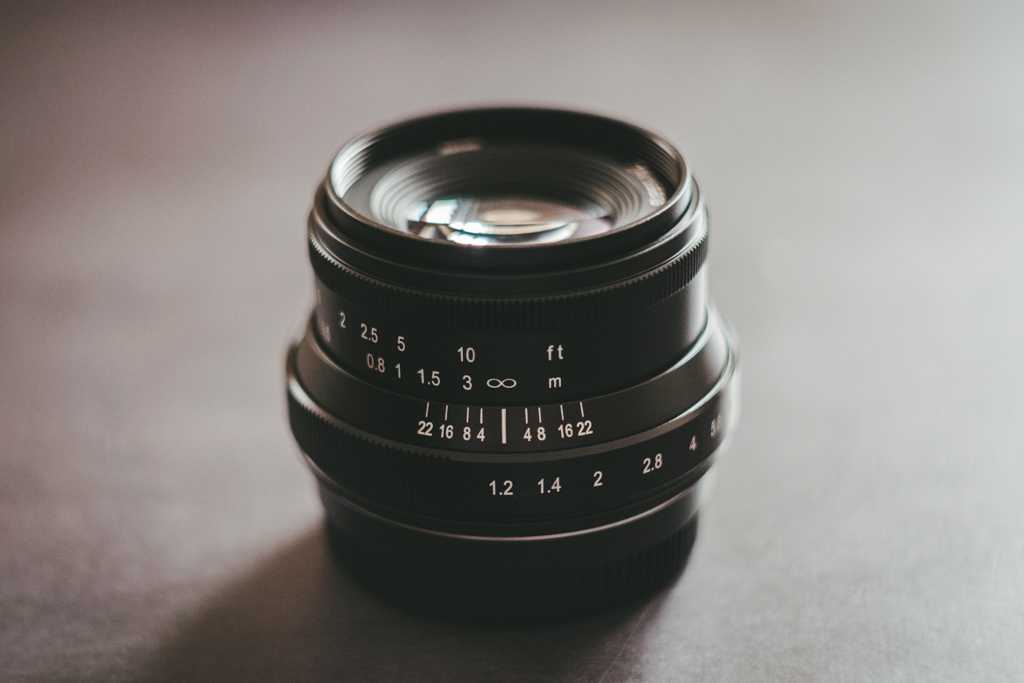 Дизайн 7Artisans 35/1.2 II
Дизайн 7Artisans 35/1.2 II
Второй важный для меня момент — дизайн. Конечно, тут изменения на лицо. 7Artisans 35/1.2 II начали выпускать только в черном цвете, и он стал выглядеть более современным. Хотя и более «бездушным», как по мне. По сути своим внешним видом он перестал отличается от стекл других производителей. Чего нельзя было сказать про его предшественника, который, на мой вкус, гораздо больше подходил к «крутилочной» концепции Fujifilm.
Третье важное изменение — мое любимое кольцо переключения диафрагмы В новой версии 7Artisans 35/1.2 оно стало кликабельным. До моего «эталона» по этому критерию (объективов линейки WR, например, Fujinon 23/2) ему все же далеко, зато теперь нет необходимости постоянно держать на контроле момент, что значение диафрагмы случайно собьется
Как по мне, данное улучшение — именно то, чего, действительно, не хватало предшественнику. Там кольцо было словно желе.
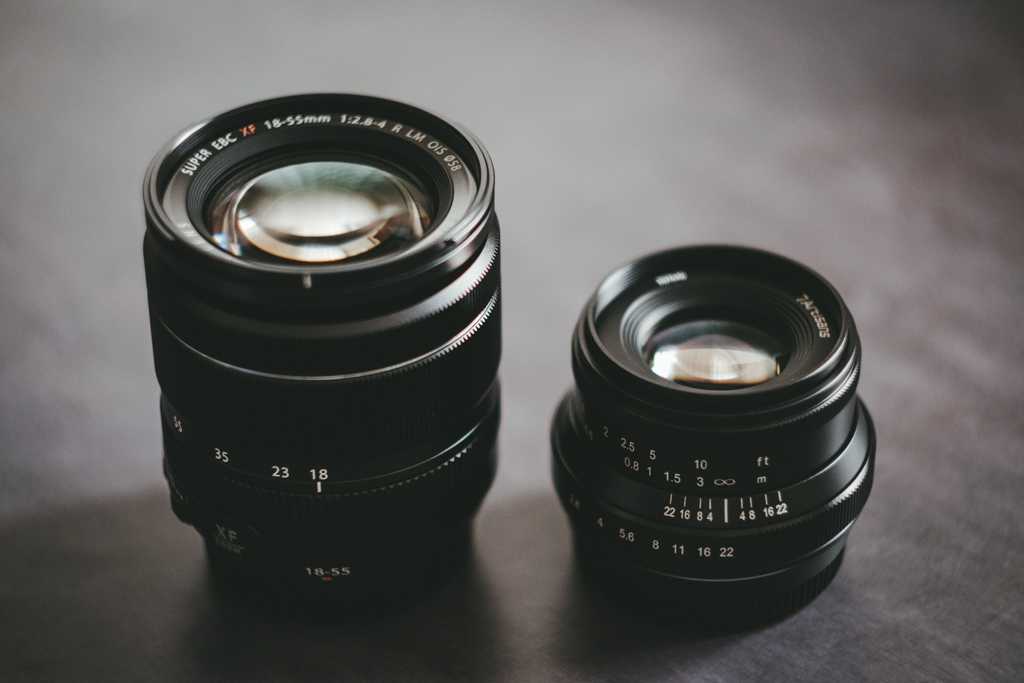 Fujinon 18-55/2.8-4 рядом с 7Artisans 35/1.2 II
Fujinon 18-55/2.8-4 рядом с 7Artisans 35/1.2 II
Как следствие, 7Artisans 35/1.2 II немного прибавил в габаритах — стал длиннее. С одной стороны, он получился чуть менее компактным, с другой — его стало удобнее скручивать с камеры. Хотя и не решило проблему целиком.
И не могу не сказать про то, что вторая версия 7Artisans 35/1.2 выросла в цене. Не на много, конечно, но для кого-то этот момент может оказаться критичным при выборе. Ведь по факту старая версия была интересна многим фотографам-любителям еще и своей доступностью относительно конкурентов.
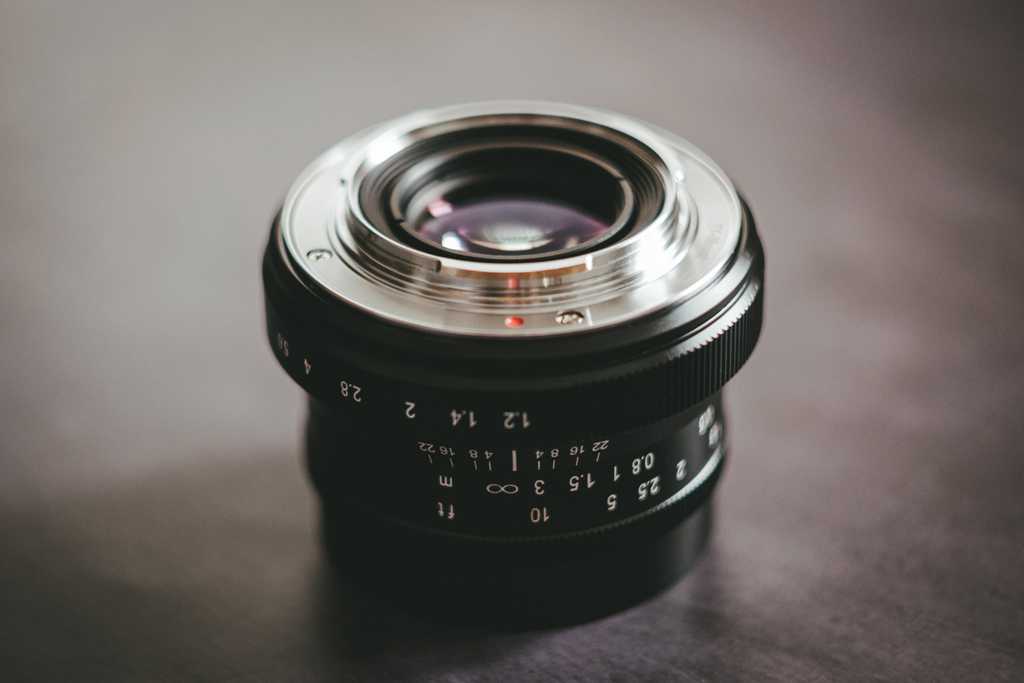 Байонет объектива 7Artisans 35/1.2 II
Байонет объектива 7Artisans 35/1.2 II
Build quality
Of course this is a little reflected in the quality of construction. It’s fair to say that the 7Artisans 35mm f/1.2 doesn’t feel the most highly polished bit of kit. It’s fairly similar to the 55mm I recently wrote about – though there are some build quality advances. Like the 55mm, the aperture isn’t clicked, though it is quite nicely damped. The focus isn’t quite a grainy feeling as my copy of the 55mm, instead it somehow feels a bit rubbery, rather than silky, if that makes any sense at all? This all said, I think it’s worth acknowledging that like the also-later-released 12mm 2.8, it has the nicer quality lens mount that doesn’t rotate quite as much on the mount at the 55mm lens does.
Focus Performance
Sony a7 III + 7artisans 35mm f/1.4 | 1/250, f/1.4, ISO 160
This is a lens that does not produce a lot of sharp images, especially if you’re new to manual focusing as I was.
I thought that this would annoy me, but it’s actually proven to be a lot of fun.
When they are sharp, they’re sharper than you’d expect for a lens of this size and price.
If you want to increase your odds of getting sharp images, it’s worth stopping down to f/2 or f/2.8, but that does then mean missing out on a lot of what makes this lens so enjoyable.
Anything that’s not towards the centre of the frame will be soft however accurately you focus, and corner sharpness is quite poor all the way through to f/8.
In addition, the lens does not entirely render sharp images when focusing at infinity.
As a result, I embraced the looseness that this gave me with my photography, and it made me appreciate the character of images produced when shooting subjects that are only a few feet away from me.
If like me, you’re new to manual focusing, there are a few tricks to increase your chances of grabbing a sharp image.
You can switch on focus peaking, which introduces an overlay to show which parts of an image are sharp. However, this is not very accurate, and it can be distracting.
Instead, set one of your customisable buttons to become a focus magnifier. This slows you down somewhat, but it is much more accurate and gives far greater consistency.
Image qualities
Bored yet? Are you just waiting for me to get to the crux of all this and start talking about image quality? Well, I’m not going to share too many thoughts as it doesn’t seem entirely fair to come to too many conclusions based on a prototype.
Instead, I’m just going to share a few sample photos along side a few short notes. I’ve added a touch of contrast to these images, but only globally; I’ve not applied any sharpening, “clarity”, or attempted to counteract vignetting or any distortions. What you see is pretty much what to expect out of an M9 for the colour images, and an MM for the black & white.
Vignetting visible here
Really nice transition to out of focus here
I spy a bit of barrel distortion
No obvious ghosting with the sun in frame here
Color Balance
This is not a chapter you usually find in my reviews, but for a set of Cine lenses I find it rather important. When having such a set I would not only expect the focus and aperture rings to be indistiguishable, but also their colour signature.
Unfortunately this is not the case here, as you will see from the following comparison.
What I did here is shooting all 3 lenses with the same white balance value dialed in (when shooting stills I usually use auto white balance). I also shot all 3 lenses side by side under the same light, all set to f/8.0. I cropped the 35mm and 50mm to give the same field of view as the 85mm, so they are more easy for you to compare.
I set the white balance using the 85mm, so this looks most neutral. The 50mm has a slight magenta teint compared to the 85 whereas the 35mm has a huge green hue.
So quickly changing between these 3 lenses may work from a mechanical point of view, but if you are looking for the same colour output the white balance setting needs to be adjusted.
Price and availability
The 7artisans Vision lenses are available now. The price has been set to $549 for the 25mm, $499 for the 35mm, and $430 for the 50mm lens. For reference, the equivalent 7artisans 25, 35, and 50mm f/0.95 photo lenses sell from $240 to $370 per lens.
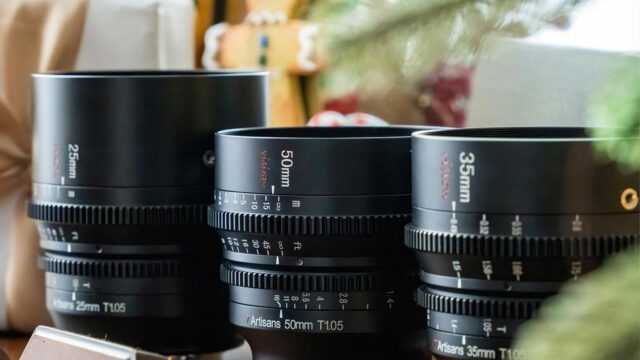 7artisans Vision cine lenses. Source: 7artisans
7artisans Vision cine lenses. Source: 7artisans
7artisans will also offer a safety protection box (with IP67 protection level) for transporting the lenses with precise foam cutouts. There is no information on whether the box will be included with the purchase or whether it has to be purchased separately. It seems to me that it will be included with the purchase of the whole set of three lenses.
7artisans 35mm
С 35-мм фокусным у 7artisans имеется сразу 3 объектива: 35mm f/1.2 для APS-C плюс 7artisans 35mm f/1.4 и 35mm f/2.0 для полного кадра. f/1.2 в APS-C и в f/1.4 в полнокадровой версии сделано, конечно, больше для хайпа, на этих значениях объективы не могут похвастаться ни резкостью, ни качеством рисунка: размытие достаточно нервное, с резкими контурами. Но стоит лишь немного закрыть его, примерно на ступень, как боке преображается, становится мягче. Что касается резкости, то тут нужно вспомнить такую вещь как зависимость от дистанции фокусировки:
Схемы с плавающими элементами (для коррекции аберраций на близкой дистанции) придумали сравнительно недавно, и во всех 7artisans 35mm (f/1.2, f/1.4, f/2.0), использующих схемы эпохи дальномерок, подобное отсутствует. Поэтому при фокусировке на объектах ближе 1 метра вы можете заметить, что объектив стал как-то сильно «мылить» изображение, хотя вы ничего не меняли. Это нормально. На дальномерных камерах большинство объективов в принципе упиралось в ограничитель на дистанции 0.7 м, из-за самого устройства видоискателя. У 7artisans 35-мм объективы фокусируются гораздо ближе – вплоть до 0.35 м, но будьте готовы к тому, что вам придется дополнительно закрыть диафрагму примерно на ступень, чтобы сохранить тот же уровень резкости, что и при фокусировке на большую дистанцию.
В целом, 35mm f/1.2 и 35mm f/1.4 лучше «остановить» на 1-2 ступени, а 35mm f/2.0 можно использовать прямо с открытой диафрагмы (особенно на APS-C камерах). Оптимальные значения по резкости и контрасту, как обычно – от f/4 до f/8. Что интересно, 35mm f/1.4 выпускается для байонетов Canon RF и Nikon Z, для которых сейчас можно найти не так много оптики, тем более за такие деньги. По какой-то странной логике версия f/1.2 (для кропа) обладает бесступенчатой диафрагмой, а f/1.4 и f/2.0 для полного кадра – оба «кликают», причем с шагом сразу в полную ступень. Как можно догадаться, это не очень хорошо для видео. Впрочем, прием с изменением глубины резкости прямо по ходу записи используется не так уж и часто, без этого можно обойтись.

Skip to the end
As you can probably see by the amount I have written about the 7Artisans 35mm f/1.2 compared to the 55mm 1.4, I’m a little more taken with it. Quite a bit more in fact. To be honest, a lot of that comes from a combination of its size when mounted on the camera, it’s effective focal length being 50mm (my preference) and it’s speed compared to my usual 2.8 carry-everywhere lens.
Like the 55mm, this lens feels to me a little like a “vintage” lens reimagined with modern coatings. It’s far from optically perfect, but has a charm in the way it renders that I really like. I could probably do without the rainbow flare, but I’m going to start experimenting with hoods to see if I can solve that. But even if I can’t, the rest of the way it renders is right up my street. Wide open, especially it has a gentle sharpness that falls off really nicely to out of focus. This is a trait I commonly find in fast Sonnar formula lenses – and as if I haven’t mentioned it enough times on this blog – this is a look I really like.
Outside of my joy for the Sonnar formula, to my mind the 7Artisans 35mm f1.2 lens does seem to offer pretty great value. It might not be built to the exacting standards of something out of the stables of the big boys, and it might offer a slightly unusual user experience but neither of these factors are deal breakers at the price point… Ultimately, if you’re looking for a 50mm equivalent fast lens for your aps-c camera, it’s hard to argue with the 7Artisans 35mm f/1.2 !
Another really interesting review here on Yukosteel.wordpress.com
Contribute to 35mmc for an Ad-free Experience
There are two ways to experience 35mmc without the adverts:
Paid Subscription — £2.99 per month and you’ll never see an advert again! (Free 3-day trial).Subscribe here.
Content contributor — become a part of the world’s biggest film and alternative photography community blog. All our Contributors have an ad-free experience for life.Sign up here.
7artisans M28mm f/1.4
По техническому качеству изображения стоит отметить 7artisans M28mm f/1.4 – удачный объектив, получивший много положительных отзывов. Его не требуется «останавливать» на 1-2 ступени для получения приятного рисунка или приемлемой резкости, в оптической схеме применяются специальные элементы из низкодисперсионного стекла, асферик и стекла с высоким коэффициентом рефракции. Объектив выпускается в 2 версиях: обычной и FE-Plus. Вторая немного оптимизирована по размерам хвостовика, чтобы он не задевал массив фильтров, расположенных перед матрицей полнокадровых камер Sony (переходник с Leica M на Sony FE в комплект не входит).

Conclusion
good
|
average
|
not good
design inconsistencies (color rendition, aperture diaphragms) |
Keep in mind I am not a videographer, so while I can evaluate these lenses’ optical performance, I cannot tell you much about their video-centric handling performance.
What would you expect of a set of cine lenses? I would expect not only shared gear positions and diameters, but also same aperture diaphragms and especially same color rendition.
When it comes to the focus and aperture rings these expectations are met, but neither for the diaphragms nor the color rendition.
When using a set of lenses for a production I wouldn’t want highlights to sometimes look very edgy (85mm) and sometimes almost round (50mm). And what is the benefit of a set of cine lenses over some random lenses when their color rendition varies significantly?
Looking at the lenses separately the 85mm is the strongest performer in my opinion. Its contrast is higher than that of the other two, bokeh is nice and the minimum focus distance surprisingly generous for an 85mm lens. And it is even an internal focus design.
The 35mm is the weakest. Performance at T2.0 could be a bit better as could be bokeh rendering and vignetting is also on the high side. It shows a very characteristic blue flare, if that is something you are after.
In terms of performance the 50mm sits somewhere in between the other two.
If you are a videographer please consider telling me in the comment section what you think of these lenses.
You can buy thes lenses from amazon.com/amazon.de | ebay.com/ebay.de | B&H for $419/379/459 and 479/379/549€ respectively (affiliate links)
Panasonic Lumix G X Vario 12–35 mm f/2.8 Asph.
|
Байонет |
микро 4/3 |
|
Формат изображения |
4/3 (17,3×13 мм) |
|
Конструкция объектива |
14 элементов в 9 группах |
|
Фокусное расстояние |
12–35 мм |
|
Фокусное расстояние (35-мм экв.) |
24–70 мм |
|
Максимальная диафрагма |
2,8 |
|
Минимальная диафрагма |
22 |
|
Угол зрения |
84° — 34° |
|
МДФ |
25 см |
|
Максимальное увеличение |
0,17х |
|
Количество лепестков |
7 (скругленные) |
|
Тип бленды |
н/д |
|
Диаметр светофильтра |
58 мм |
|
Дополнительные возможности |
оптический стабилизатор POWER O. I. S. |
|
Размеры |
Ø67,6 ×74 мм |
|
Вес |
305 г |
Первый для формата микро 4/3 профессиональный зум-объектив высшего класса с классическим диапазоном фокусных расстояний, эквивалентным 24–70 мм в 35-мм формате, и постоянной светосилой F2,8 на всем диапазоне. Металлический корпус и всепогодная защита значительно увеличивают ресурс и расширяют область применения объектива, а специальное нанопокрытие поверхностей линз уменьшает аберрации и снижает риск засветки и образования бликов. В оптическую схему включено несколько элементов из особых сортов стекла; в результате обеспечивается превосходное качество изображения по всему полю кадра. Объектив снабжен профессиональной системой оптической стабилизации изображения POWER O. I. S., в два раза более эффективной, чем стандартная MEGA O. I. S., а новая система автофокуса, оптимизированная для видеосъемки, обеспечивает мгновенную и бесшумную фокусировку. При этом объектив получился компактным и легким, по размерам не сильно отличаясь от простого штатного зума.
Цена $1860 В НАЧАЛО ОБЗОРА
7Artisans 35mm f/1.2 Image quality
Well, where to start? Optically, the 7Artisans 35mm f/1.2 is far from perfect. You’d be mad to expect it to be perfect at this price point/size/specification. In fact, in some ways it’s a little crazy.
Flare
To start with, check out this flare. I’ve spotted this a few times now, but this is the only shot I captured it in such glory. Funnily enough, despite it being of a very different optical design, the m-mount voigtlander 35mm 1.4 also exhibits rings of rainbow flare, though not to this extent.
It’s also prone to some quite heavy veiling flare with a light source behind the subject.
Distortion
I’ve also noticed some distortion – this seems to be most noticeable when closer focusing, though to be honest I perhaps havent shot it exhaustively enough to confirm that… One way or another, barrel distortion is definitely a thing here! You can see this in the image of Stanley above (look at the top of the radiator), and in the wall to the far right here:
Smoogy corners
The issue with I’ve noticed that will likely bother the most picky is a slight smearing into the far corners, even stopped down. Personally, I don’t find this an issue as I’m most likely to be using the lens wide open at closer quarters where this won’t be noticeable. If you’re a bit of a perfectionist and looking for the perfect carry-everywhere, this might bother you…
Contrast and Resolution
Short of the corners, it’s an acceptably sharp lens. Of course, it’s far from the likes of the Voigtlander 50mm f/3.5 which gave me a bit of a benchmark for just how capable these little Sony a5100 cameras can be when it comes to resolving what a lens is capable of. By comparison this lens’s resolution is quite low, especially wide open.
That being said, subjectivity speaking I’m more than happy with the results. Bear in mind this is a camera/lens combo I’m mostly likely to use for photography of my kids, perfect sharpness isn’t exactly something I’m going to be too worried about.
Wide open contrast can be a touch low too. I’ve upped the overall contrast of the images in this post which of course hides it a bit, but you can still see the impact of the lower wide open contrast.
The glow
I think it’s also worth noting the “glow” when shot wide open. The transition to out of focus is emphasised a little by what’s probably a bit of spherical aberrations. This gives that slightly glowy feel to what’s close to in focus. Combined with the slightly lower resolution, to my mind that amounts to a really nice gentle rendering. But I’m sure it won’t be to everyone’s tastes.
f/1.2 – close focus – good bit of “glow” and slightly whacky Bokeh
Bokeh
Wide open bokeh can be a little wild, but to be honest, it’s not as barmy as I expected it to be. Depth of field is far from as shallow as the 50mm 1.1 on the Leica, as such the out of focus rendering isn’t quite as overbearing or prominent feeling in equivalent photos. That being said, it’s certainly not the perfectly smooth and creamy bokeh some people seem to strive for.
Pardon the missed focus – shot at f/1.2f/2.8
Final thoughts
One thing to bear in mind – as mentioned – 7Artisans 35mm f/2 is not going to give you modern objectively perfect results. It’s a 7/5 Sonnar design, even if the results are different in the final version, they’re still not going to compare in the conventionally ideal image quality states to a asph-cron (for eg). On one hand what we do have here is shaping up to be a really nice entry level 35mm fast(ish) lens for those on a budget. On the other hand a lens that’s going to have stacks of character to please the likes of me. If you fit into either of those categories, keep your eyes peeled for more… and if you would like to be notified when you’ll be able to place a pre-order for the 7Artisans 35mm f/2, here’s a box to fill in:
Contribute to 35mmc for an Ad-free Experience
There are two ways to experience 35mmc without the adverts:
Paid Subscription — £2.99 per month and you’ll never see an advert again! (Free 3-day trial).Subscribe here.
Content contributor — become a part of the world’s biggest film and alternative photography community blog. All our Contributors have an ad-free experience for life.Sign up here.
7artisans 25mm f/1.8
7artisans 25mm f/1.8 – один из самых популярных объективов бренда. По крайней мере, в России. Своей популярности он обязан, прежде всего, низкой цене – многие любители, только недавно купившие фотоаппарат с «китовым» зумом, не готовы к новым тратам, а хочется снимать с размытием. Второй фактор: универсальное фокусное расстояние: на APS-C с учетом кроп-фактора получается около 37-40 мм, а на Micro 4/3 – классический «полтинник». Хорошо подходит для повседневной съемки (дети, друзья, цветы, коты, что-то интересное по дороге) и портретов с доступным светом. Объектив супер-компактный, а качество изображения превзойдет ваши ожидания – хорошая резкость и приятное, мягкое боке (для лучших результатов советуем чуть-чуть прикрыть диафрагму) – что еще вам надо? Да, фокусироваться придется вручную, но с новыми камерами это несложно (подробнее ниже). Так что просто берите и начинайте снимать.

Bokeh
35mm
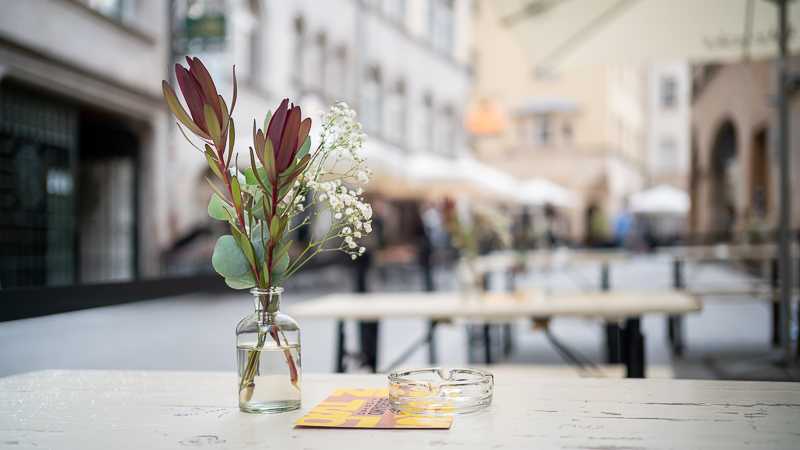 Sony A7rII | 7Artisans 35mm 2.0 Spectrum | T2.0
Sony A7rII | 7Artisans 35mm 2.0 Spectrum | T2.0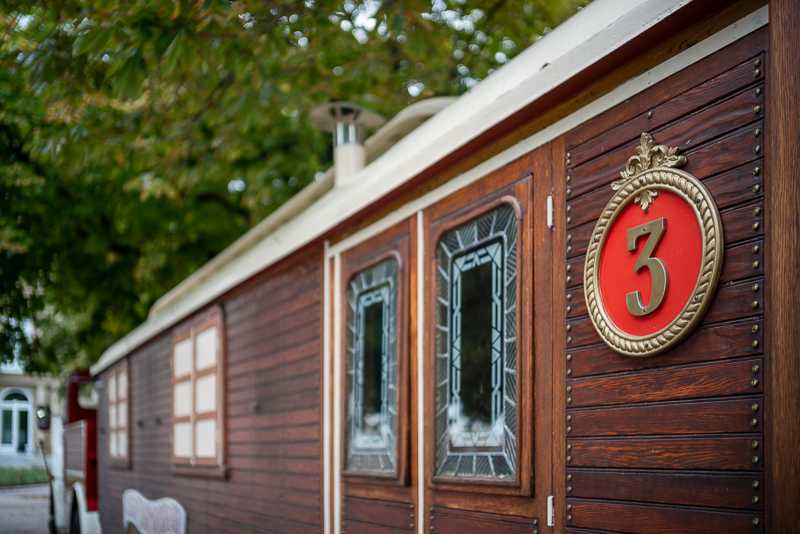 Sony A7rII | 7Artisans 35mm 2.0 Spectrum | T2.0
Sony A7rII | 7Artisans 35mm 2.0 Spectrum | T2.0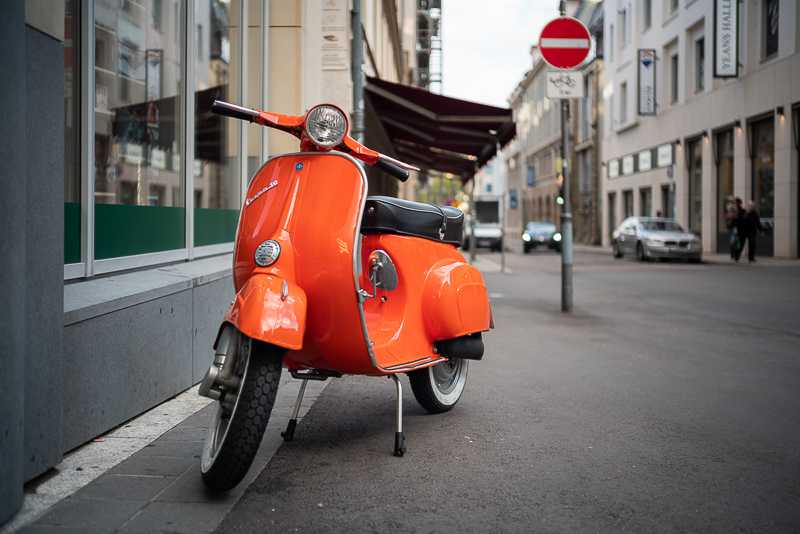 Sony A7rII | 7Artisans 35mm 2.0 Spectrum | T2.0
Sony A7rII | 7Artisans 35mm 2.0 Spectrum | T2.0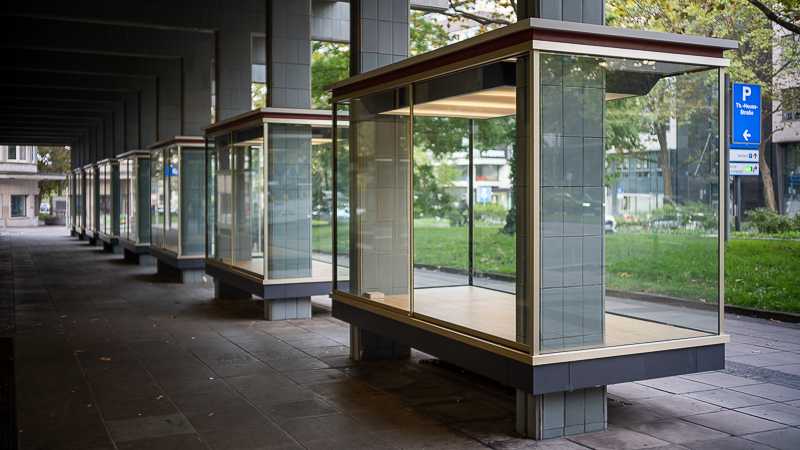 Sony A7III | 7Artisans 35mm 2.0 Spectrum | T2.0
Sony A7III | 7Artisans 35mm 2.0 Spectrum | T2.0
A T-Stop of 2.0, which should amount to something like f/1.8, is unlikely to yield spectacularly blurry backgrounds at longer focus distances when it comes to a 35mm lens.
At close to mid distances the bokeh rendering looks okay to me, but at longer focus distances the corner and border regions get a bit messy as I see strong and . I am not a fan of this, but I guess these days there are also people around looking for a more “classic” rendering, who might be happy with this.
50mm
 Sony A7rII | 7Artisans 50mm 2.0 Spectrum | T2.0
Sony A7rII | 7Artisans 50mm 2.0 Spectrum | T2.0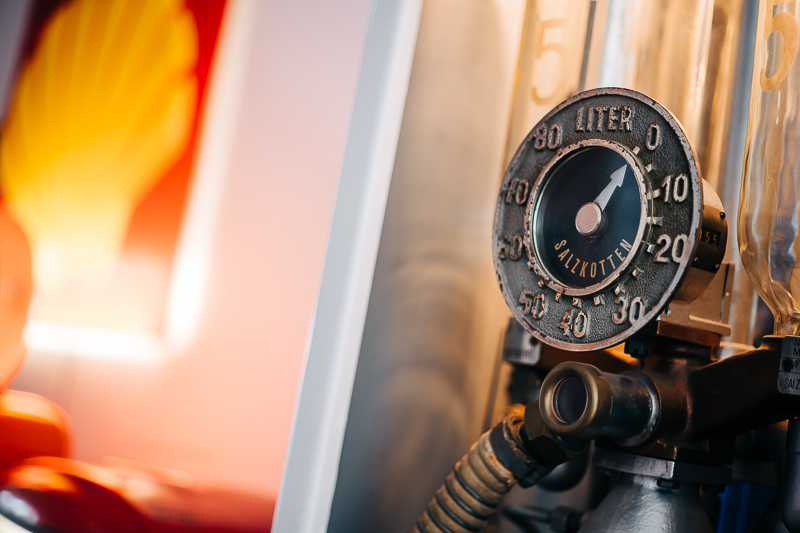 Sony A7rII | 7Artisans 50mm 2.0 Spectrum | T2.0
Sony A7rII | 7Artisans 50mm 2.0 Spectrum | T2.0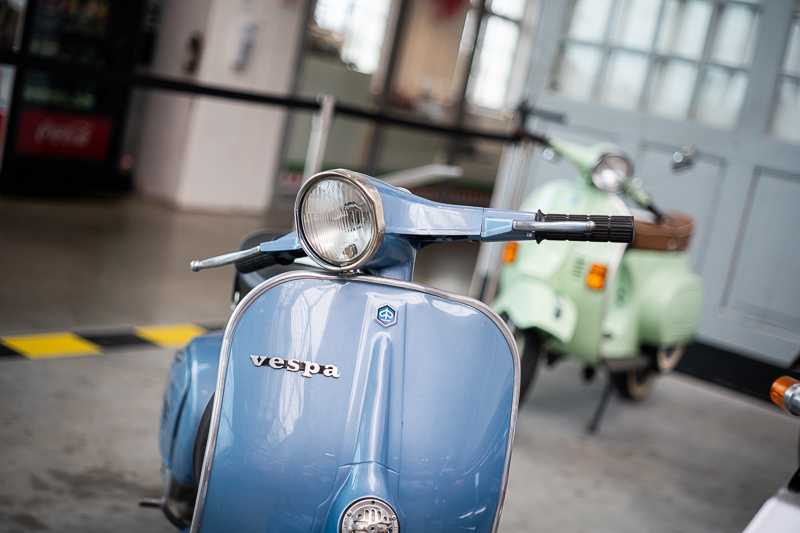 Sony A7rII | 7Artisans 50mm 2.0 Spectrum | T2.0
Sony A7rII | 7Artisans 50mm 2.0 Spectrum | T2.0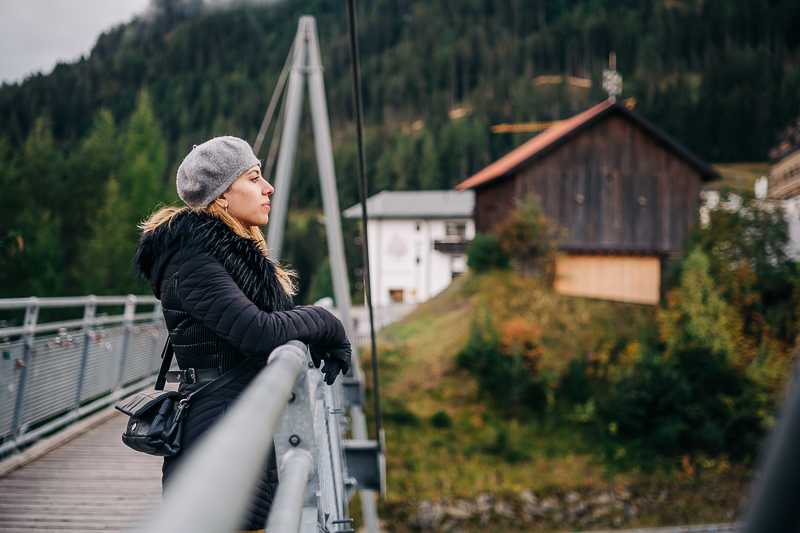 Sony A7III | 7Artisans 50mm 2.0 Spectrum | T2.0
Sony A7III | 7Artisans 50mm 2.0 Spectrum | T2.0
The 50mm has a bokeh very typical of what you are used to from legacy SLR 50mm f/1.8 lenses, of which we have reviewed many here. It has a tendency to show outlining and double edged structures – especially at longer focus distances – and bokeh fringing is also present, so you will often spot green outlining in the background around contrasty edges.
Still, contrast and resolution are good at focus point from T2.0, so the subject separation is not bad.
85mm
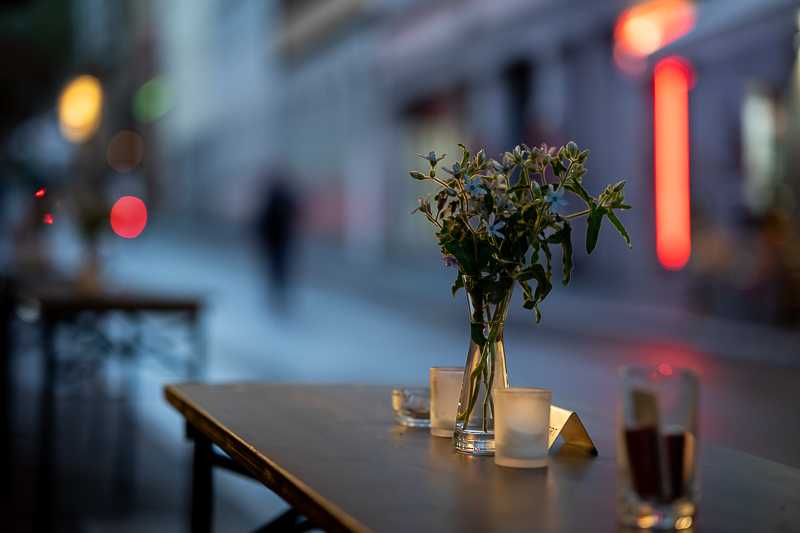 Sony A7III | 7Artisans 85mm 2.0 Spectrum | T2.0
Sony A7III | 7Artisans 85mm 2.0 Spectrum | T2.0 Sony A7III | 7Artisans 85mm 2.0 Spectrum | T2.0
Sony A7III | 7Artisans 85mm 2.0 Spectrum | T2.0
In this category the 85mm lens is my favorite of the three, but that shouldn’t come as such a big surprise, I have to think hard to come up with a fast 85mm lens with really bad bokeh rendering.
The bokeh is generally smooth even at longer distances and highlights are very clean: no outlining, no strong bokeh fringing, no onion rings.
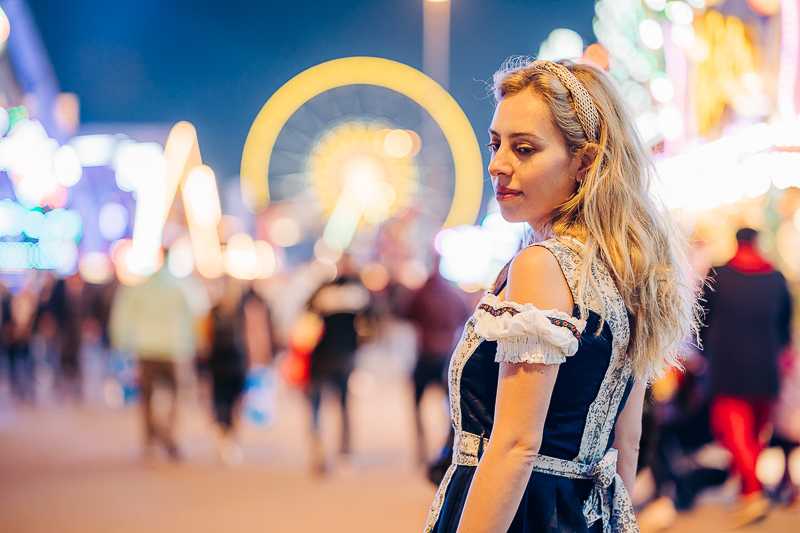 Sony A7III | 7Artisans 85mm 2.0 Spectrum | T2.0
Sony A7III | 7Artisans 85mm 2.0 Spectrum | T2.0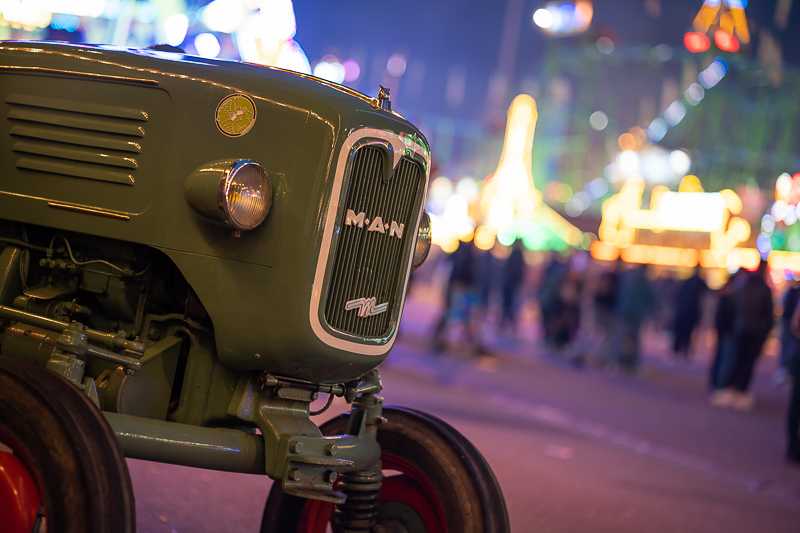 Sony A7III | 7Artisans 85mm 2.0 Spectrum | T2.0
Sony A7III | 7Artisans 85mm 2.0 Spectrum | T2.0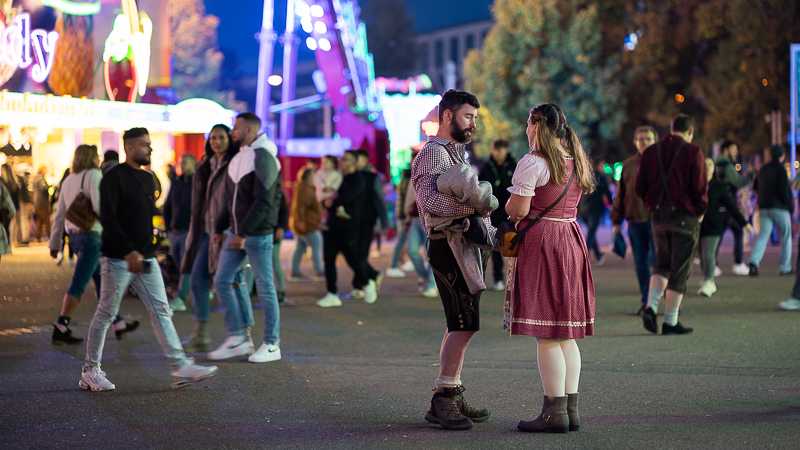 Sony A7III | 7Artisans 85mm 2.0 Spectrum | T2.0
Sony A7III | 7Artisans 85mm 2.0 Spectrum | T2.0
When stopping down the straight aperture blades are very obvious though. Personally I am not a fan of this, as it looks very unnatural to me:
Sony A7III | 7Artisans 85mm 2.0 Spectrum Cine | 7A Soft Mist 1/4
Vignetting
light falloff
| 35mm | 50mm | 85mm | |
| T2.0 | 3.1 EV | 2.0 EV | 1.7 EV |
| T2.8 | 2.3 EV | 1.2 EV | 1.0 EV |
| T4.0 | 2.0 EV | 0.6 EV | 0.7 EV |
| T5.6 | 1.9 EV | 0.5 EV | 0.5 EV |
| T8.0 | 1.8 EV | 0.5 EV | 0.5 EV |
| T11 | 1.8 EV | 0.5 EV | 0.5 EV |
When seeing the big casings of cine lenses many people think the glass elements are also bigger in diameter and that will lead to lower vignetting figures, but usually this is not the case.
Unsurprisingly the 35mm 2.0 shows the highest Vignetting figures, especially stopped down where it is still almost 2 stops. The 50mm and 85mm show noticeably lower vignetting and in both cases it should hardly be a problem even at wider apertures and hardly noticeable from T4.0 onwards.
Generally this is an average performance, similar to still lenses with comparable specifications.
It is recommended to have a look at this article first to get an idea how this brightness graph works.
What is also surprising is the very low vignetting stopped down, by f/5.6 it is hardly noticeable anymore. The only other 50mm lenses I have used that show this little vignetting stopped down are the Samyang 50mm 1.2 XP and the Sigma 50mm 1.4 EX.
optical vignetting
Fast lenses usually show a noticeable amount of optical vignetting. Without going too much into technical details optical vignetting leads to the truncation of light circles towards the borders of the frame.
In the center of the frame almost every lens will render a perfect circle, but only lenses with very low optical vignetting will keep this shape in the corners.
So in the following comparison we move from the center (left) to the extreme corner (right) and see how the shape of the light circle changes.
There are no real surprises here when it comes to the amount of optical vignetting and none of the lenses is making use of aspherical elements, so onion rings are not an issue either.
The different aperture constructions are very noticeable when stopping the lenses down to T2.8 though: the 50mm uses 12 rounded aperture blades, so the highlights are mostly round at T2.8, the 35mm uses 10 mostly straight blades leading to more edgy highlights and the 85mm uses very “sharp”, Loxia-like aperture blades, leading to obvious decagons.
Dealing with a set of Cine lenses, I would have hoped for more consistency here.
The lines running through the circles are due to the glass I used as a mirror to take these pictures and are not a feature of the lens.
I used the following distances: 0.5m for the 35mm, 0.7m for the 50mm and 1.1m for the 85mm. Results may vary at other distances.
Flare and Sunstars
Sony A7III | 7Artisans Spectrum Cine lenses
I have the feeling in the videography world lens flares are more often used for artistic purposes, so I tried to show you what the lens flares typically look like with these three lenses.
The 35mm shows a very obvious purple/blue streak around strong point light sources. With the 50mm there is only a very small purple/green streak and with the 85mm only a small dot.
Despite the recessed front element stray light can be an issue though, so it might be necessary to shade the lens in certain situations.
All three lenses also create rather obvious sunstars stopped down, but keep in mind the 50mm will produce 12 streaks whereas it is 10 streaks for the other two.
Conclusion
I think this is a fantastic choice for a 35mm lens to throw on your film or digital Leica or any mirrorless camera for that matter. It’s an awesome first step into M-mount glass that I would not hesitate to recommend to my closest friends. With a price that is expected to be less than $400 its a no-brainer for someone looking for a native m-mount lens. You will not be disappointed by the results of this lens if you like the images you’ve seen taken with this lens online.
I think 7Artisans have knocked it out of the park with this one and I’m eagerly awaiting their next release. I for one will have a huge grin on my face when this company (and China as a whole) eventually releases a lens that the Leica community (of which I am a part) will have no choice but to accept as something of equal or greater quality to their beloved lenses.
Lenses are just another tool to achieve your unique perspective in the art of photography and every lens offers a different way of viewing the world through a culmination of its characteristics. Choose a lens that best fits your unique style. There are no wrong choices, and as far as I’m concerned, you cannot really go wrong with this lens.
Keep an eye out for it in May.
Casey
7artisans 12mm f/2.8
7artisans 12mm f/2.8 – сверхширокоугольный объектив с исправленной геометрией. Дисторсия подушкообразной формы составляет всего 0.6%, а хроматика практически отсутствует, что делает данный объектив более чем пригодным для классической пейзажной фотографии, архитектуры и интерьеров
Он также обеспечивает достаточно широкий угол для селфи с вытянутой руки, даже на Micro 4/3 – обратите внимание, блогеры. Несмотря на свою «несерьезную» цену, объектив обеспечивает хорошую резкость, причем прямо от f/2.8, а также качественную цветопередачу и достаточно красивое боке (при съемке крупных планов)
Контровому свету он противостоит плохо, как и другие объективы 7artisans – все-таки, в такой ценовой категории сложно ожидать новейших просветляющих нано-покрытий, которые используются в профессиональных линейках больших брендов. Тем не менее, эту засветку можно применять в собственных творческих целях – блики и ореолы от лучей света зачастую только добавляют изображению привлекательности.

Заключительные мысли
Может показаться, что я настроен скептически относительно данной линзы. Отчасти это, действительно, так. Ведь, приобретя 7Artisans 35mm F1.2 II, я не получил «олдовость», которая мне так нравилась в первой версии. Но, если отбросить момент субъективности и вкусов, 7Artisans 35/1.2 II — это все тот же добрый творческий объектив со своим характером, который может подарить своему владельцу целый букет позитивных эмоций.
P. S.: примеры старых картинок с объектива и новых (по мере появления) можно посмотреть по тегу 7Artisans 35/1.2.
Удачных кадров и хорошего дня!
Поддержать «Фотик в деревне»:
Если статья вам понравилась, и информация в ней оказалась полезной, поддержите блог, нажав на кнопки «Поделиться».
Также можно выразить благодарность в виде доната:
Спасибо за поддержку!
Build quality
Looking at the 50mm f/1.1 it’s fair to say that we aren’t quite talking Leica or Zeiss quality, but considering the price difference, the build quality difference is quite impressive.
Compare the 35mm to the 50mm though, and it would seem 7Artisans have taken a leap forward in quality standard. I’d go as far to say that this new 7Artisans 35mm f/2 is quite a bit higher quality than the 50mm f/1.1. Both lenses feel solid and well built, but this 35mm feels a little like it’s been built to much tighter tolerances.
This is primarily borne out in what feels like a much smoother focus mechanism and a clicked and normally spaced aperture control. But more than this, somehow the material it’s made from feels more solid! Even in this prototype, the build quality gap between 7Artisans and the likes of Voigtlander and Zeiss ZM lenses has been closed, if not shut! It’s quite impressive!
7artisans Vision cinema lenses
As I mentioned above, the company starts the fully manual Vision primes line with three focal lengths:
- 25mm T1.05 – 58.6° angle of view (APS-C)
- 35mm T1.05 – 44° angle of view (APS-C)
- 50mm T1.05 – 31.8° angle of view (APS-C)
Those seem like standard focal lengths for a full-frame sensor, but don’t be mistaken – the lenses only cover APS-C sensors. Funnily enough, for some of the promotional photos, 7artisans mounted the lenses on Sony FX3, which does not even have APS-C crop mode. Anyway, let’s take a look at some more specs.
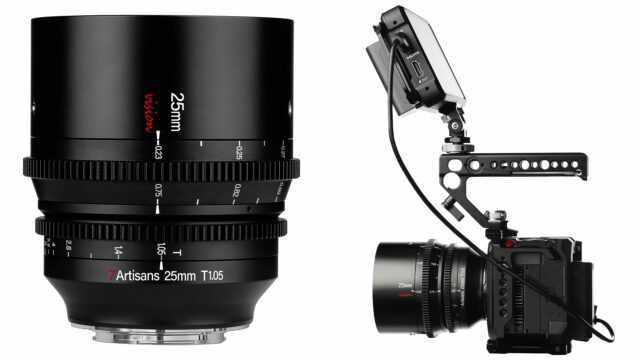 7artisans Vision 25mm T1.05 cine lens. Source: 7artisans
7artisans Vision 25mm T1.05 cine lens. Source: 7artisans
As 7artisans already offer 25, 35, and 50mm f/0.95 photo lenses, my bet is that these are the same lenses, only rehoused in a cine enclosure. The geared aperture ring is, of course, clickless. The aperture consists of 13 blades (12 blades for the 35mm) and it is available between T1.05 and T16.
7artisans claim that the lenses show minimal focus breathing. The geared focus ring has a 270° focus throw. The minimum focusing distance is 0.23m for the 25mm lens, 0.37m for the 35mm lens, and 0.5m for the 50mm lens.
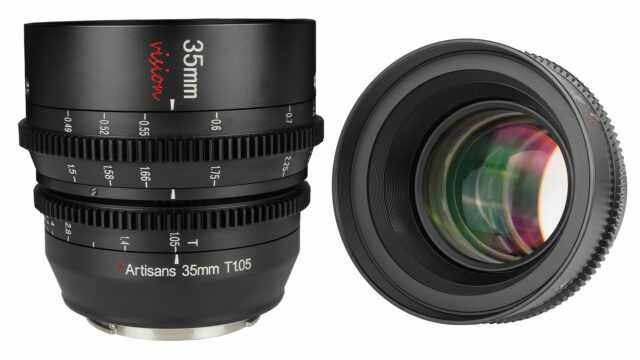 7artisans Vision 35mm T1.05 cine lens. Source: 7artisans
7artisans Vision 35mm T1.05 cine lens. Source: 7artisans
When it comes to optical structure, the 25mm lens has 11 elements in 9 groups, the 35mm lens has 11 elements in 8 groups, and the 50mm lens comprises 7 elements in 5 groups. The lenses feature an 82mm front filter thread.
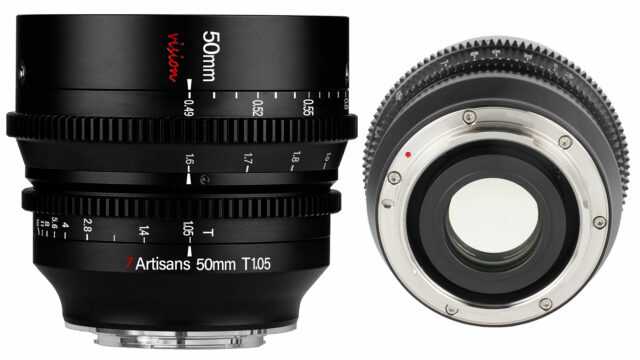 7artisans Vision 50mm T1.05 cine lens. Source: 7artisans
7artisans Vision 50mm T1.05 cine lens. Source: 7artisans
7artisan Vision lenses feature a full-metal construction. Unlike other cinema lenses, these three lenses are not the same size – they vary in length, but the diameter is the same for all three. Thankfully, the position of the focus and aperture rings is also the same across all three lenses. The lens size and weight are as follows:
- 25mm T1.05 – 89.6x106mm, around 956g
- 35mm T1.05 – 89.6x85mm, around 753g
- 50mm T1.05 – 89.6×85.4mm, around 679g
When it comes to lens mounts, all three lenses were designed for mirrorless cameras, so they will be available for Sony E, Canon RF, Leica L, FUJIFILM X, and Micro Four Thirds lens mounts. On their webpage, 7artisans also claims that the lenses will be compatible with BMPCC 6K cameras (Canon EF mount), but I suppose that is only a mistake.
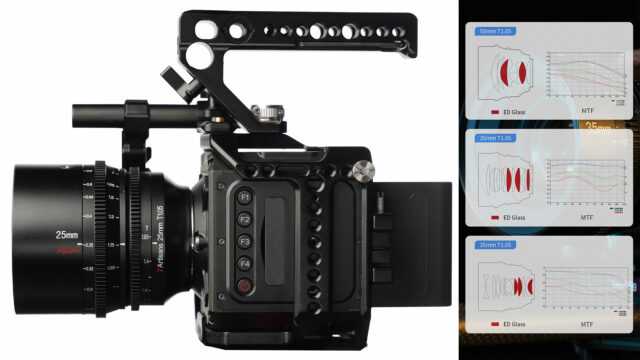 7artisans Vision – rig and MTF chart. Source: 7artisans
7artisans Vision – rig and MTF chart. Source: 7artisans
Full frame equivalence
Probably the most eye catching thing about this lens is its on-paper specification as a f/1.2 35mm. Unfortunately, it’s only designed to be used on aps-c cameras, as such, that specification is a little less exciting than it would be if it was a full frame lens.
Comparing it to a full frame lens on a full frame camera, in terms of perspective and depth of field with the same framing, the 7Artisans 35mm f/1.2 is equivalent to a 50mm lens (ish) field of view with a maximum aperture of around 1.8. Of course, whilst that’s a little less exciting if you’re used to shooting full frame cameras, it is a fairly unique specification when combined with the size and price of this lens. The wider aperture with slightly broader DOF than a fast lens on a full frame camera also narrows the gap in terms of the low light performance comparison with a bigger camera too.



























